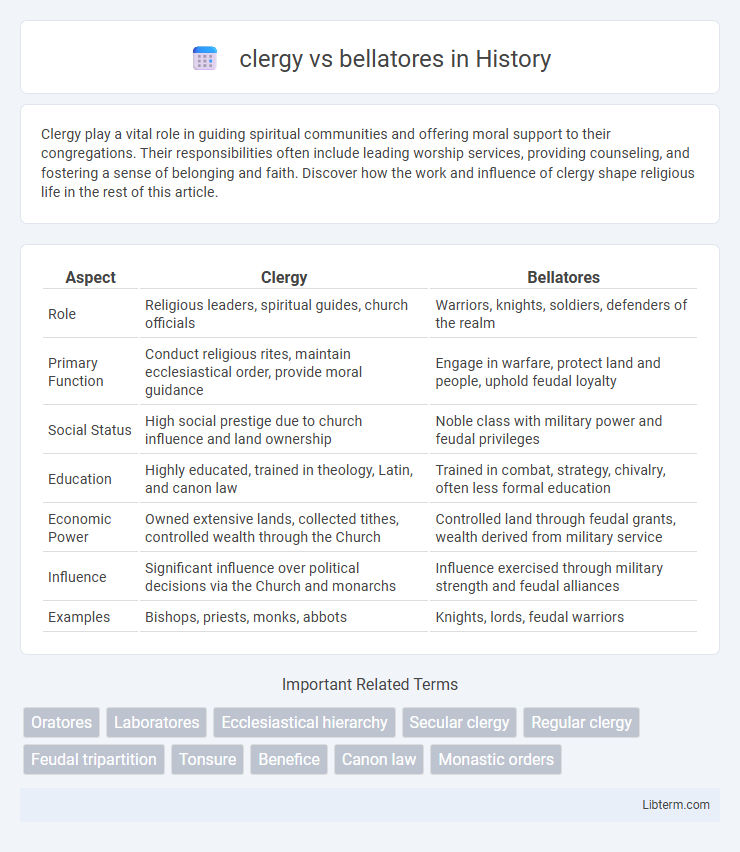Clergy play a vital role in guiding spiritual communities and offering moral support to their congregations. Their responsibilities often include leading worship services, providing counseling, and fostering a sense of belonging and faith. Discover how the work and influence of clergy shape religious life in the rest of this article.
Table of Comparison
| Aspect | Clergy | Bellatores |
|---|---|---|
| Role | Religious leaders, spiritual guides, church officials | Warriors, knights, soldiers, defenders of the realm |
| Primary Function | Conduct religious rites, maintain ecclesiastical order, provide moral guidance | Engage in warfare, protect land and people, uphold feudal loyalty |
| Social Status | High social prestige due to church influence and land ownership | Noble class with military power and feudal privileges |
| Education | Highly educated, trained in theology, Latin, and canon law | Trained in combat, strategy, chivalry, often less formal education |
| Economic Power | Owned extensive lands, collected tithes, controlled wealth through the Church | Controlled land through feudal grants, wealth derived from military service |
| Influence | Significant influence over political decisions via the Church and monarchs | Influence exercised through military strength and feudal alliances |
| Examples | Bishops, priests, monks, abbots | Knights, lords, feudal warriors |
Introduction to Clergy and Bellatores
Clergy represent the religious leaders and officials responsible for spiritual guidance, rituals, and maintaining religious doctrines within medieval society. Bellatores, or the warrior class, consist of knights and nobles tasked with military protection, governance, and upholding feudal order through combat and defense duties. Both groups played crucial roles in shaping the social hierarchy and power dynamics during the Middle Ages.
Historical Origins of the Clergy
The clergy originated in early Christian communities as a distinct social class dedicated to religious duties and spiritual leadership, distinguishing themselves from the bellatores, or the warrior class, in medieval feudal societies. Rooted in the Roman Empire's transition to Christianity, the clergy's authority expanded through ecclesiastical hierarchy, emphasizing sacramental roles and moral guidance. This separation underscored the clergy's function as mediators between God and society, contrasting the bellatores' role in military protection and feudal governance.
Emergence of the Bellatores Class
The emergence of the bellatores class, or the warrior nobility, occurred during the early medieval period as feudal societies structured themselves around military service and land ownership. This class distinguished itself from the clergy by its primary role in warfare, protection, and governance, acquiring lands granted by monarchs in exchange for loyalty and martial support. The bellatores gradually asserted significant influence in political and economic spheres, setting the foundation for the medieval nobility's dominance.
Roles and Responsibilities: Clergy vs Bellatores
The clergy primarily undertook spiritual duties such as administering sacraments, guiding moral conduct, and preserving religious knowledge within medieval society. Bellatores, the warrior class, focused on military defense, protection of territories, and enforcement of law and order through armed force. While clergy wielded influence through religious authority and education, bellatores maintained social stability by ensuring security and upholding feudal obligations.
Spiritual Authority versus Martial Power
Clergy wield spiritual authority grounded in religious doctrine and moral guidance, shaping societal values and legitimizing political structures through divine sanction. Bellatores, or the warrior class, exercise martial power by enforcing territorial control and defending realms via military prowess and organized combat. This dichotomy underscores medieval society's balance between ecclesiastical legitimacy and martial dominance, where the clergy's influence stabilizes order while the bellatores secure physical protection.
Interactions and Conflicts between Clergy and Bellatores
Conflicts between clergy and bellatores primarily stemmed from differing interests over land, authority, and justice in medieval society, often resulting in disputes over jurisdiction. Clergy wielded spiritual power and sought to influence secular rulers while bellatores, as knights and nobles, controlled military force and governance, leading to frequent clashes regarding the extent of ecclesiastical versus temporal authority. Interactions included negotiated alliances, power struggles, and occasional violent confrontations, highlighting the complex tension between religious and martial roles in feudal governance.
Influence on Medieval Society and Politics
The clergy held significant influence over medieval society and politics through control of spiritual authority, education, and moral guidance, often legitimizing rulers and shaping laws. Bellatores, the warrior nobility, exercised direct political power by defending territories, enforcing law, and commanding armies, thus maintaining the feudal order. The dynamic between clergy and bellatores created a balance of spiritual versus temporal power that structured medieval governance and societal hierarchy.
Church-State Relations: Collaboration and Tension
The clergy and bellatores represented two dominant medieval power structures, often collaborating to legitimize royal authority and enforce social order through intertwined religious and military functions. Conflicts arose from competing interests over jurisdiction and influence, especially regarding taxation, legal authority, and control of land, which fueled ongoing Church-State tensions. This dynamic shaped the development of political theories on sovereignty and ecclesiastical autonomy throughout the Middle Ages.
Clergy and Bellatores in Literature and Art
Clergy and Bellatores frequently emerge in literature and art as symbolic representations of spiritual authority and martial power, respectively. Medieval manuscripts and illuminated texts often depict clergy adorned in elaborate vestments, emphasizing their role in religious guidance and intellectual pursuits, while bellatores are portrayed in armor, signifying their duty to protect and govern. Artistic works such as tapestries, frescoes, and epic poetry highlight the complementary yet distinct societal functions these classes fulfill, reflecting the intertwined nature of faith and feudal responsibility in historical narratives.
Lasting Legacy of Clergy and Bellatores
The lasting legacy of clergy and bellatores highlights the foundational roles they played during the medieval period, shaping societal structures and cultural norms. Clergy, as spiritual leaders and educators, preserved religious knowledge and influenced moral frameworks, while bellatores, or warriors, upheld feudal order and defended territories, enabling political stability. Their intertwined contributions established the hierarchical system that defined medieval Europe and impacted legal, social, and military institutions for centuries.
clergy Infographic

 libterm.com
libterm.com